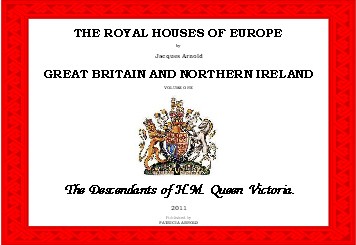 |
The Royal Houses of Europe - Series of Genealogical Books
By Jacques Arnold DL
These books provide a full royal genealogy laid out in inter-connected royal family trees of the Royal Houses of Europe. They cover the reigning monarchies of Europe, the great imperial dynasties and, the former monarchies of Europe. They include the British Royal House, now the House of Windsor, from Queen Victoria and the dynasties of Stuart, Hanover and Saxe-Coburg-Gotha. The dynasties of Hohenzollern, Romanov, Habsburg, Bourbon and Bonaparte have separate books on each, together with the Monarchies of Scandinavia, the Benelux, Iberia, Italy and the Balkans.
(Published by Royal Houses of Europe)
Discounts are available for CMA supporters. For information on these, e-mail royalhouses@uwclub.net
|
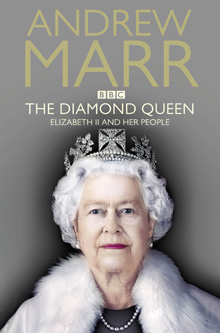
|
The Diamond Queen: Elizabeth II and Her People
By Andrew Marr
With the flair for narrative and the meticulous research that readers have come to expect, Andrew marr turns his attention to the monarch- and to the monarchy, chronicling the Queen's pivotal role at the centre of the state, which is largely hidden from the public gaze, and making a strong case for the institution itself. Arranged thematically, rather than chronologically, Marr dissects the Queen's political relationships, crucially those with her Prime Ministers; he examines her role as Head of the Commonwealth, and her deep commitment to that Commonwealth of Nations; he looks at the drastic changes in the media since her accession in 1952 and how the monarchy- and the monarch- have had to change to adapt as a result.
Indeed he argues that under her watchful eye the monarchy has been thoroughly modernised and made fit for purpose in the 21st century as it was when she came to the throne and a 'new Elizabethan age' was ushered in.
(Published by Panmacmillan: 2012)
https://www.panmacmillan.com/author/andrew-marr/the-diamond-queen/9781035001644 |
|
Young Prince Philip: His Turbulent Early Life
By Philip Eade
A revelatory and racy biography of the early life of Prince Philip.
Married for more than sixty years to the most famous woman in the world, Prince Philip is the longest-serving royal consort in British history. Yet while he is still one of the most recognisable figures in public life his origins remain curiously shrouded in obscurity.
In Young Prince Philip, the first to focus exclusively on his life before the coronation, Philip Eade recounts the Prince's extraordinary upbringing in Greece, France, Nazi Germany and Britain where he inhabited a notably colourful mileau yet was beset by continual turbulence and a succession of family tragedies.
This revealing book examines the formative psychological effects of having a mother who was born deaf and was committed to a psychiatric clinic when Philip was nine and a father who was so traumatised by his treatment at the hands of Greek revolutionaries that he later left his young son to be brought up by his wife's family, the Milford-Havens and Mountbattens just when Philip needed him most.
Remarkably there emerged from this unsettled background a character of singular vitality and dash- self-confident, capable, famously opinionated and desvastatingly handsome. Girls fell at his fee, and the princess who would become his wife was smitten from the age of thirteen. Yet alongside the considerable charm and intelligence, the young prince was also prone to volcanic outbursts and to putting his foot in it. Detractors percieved in his behaviour emotional short-comings, a legacy of his traumatic childhood, which would have profound consequences for his family and the future of the monarchy.
Containing new material from interviews, archives and film footage, Young Prince Philip is the most complete and compelling account yet of his storm-tossed early life.
(Published by HarperPress: 2012) |
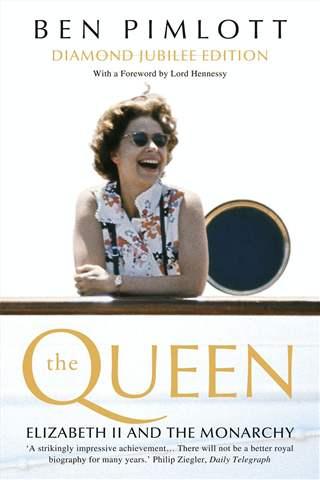
|
The Queen: Elizabeth II and the Monarchy
By Ben Pimlott
An updated edition of Ben Pimlott's magisterial biography of the Queen; "...there is no better biography of Elizabeth II," according to Prof Peter Hennessy (Queen Mary College, University of London).
The royal family have been through a tumultuous decade but with the wedding of Prince William and Kate Middleton, Prince Philip's 90th birthday and the Diamond Jubilee celebrations, there is a renewed interest and appreciation of our monarchy. The Queen is an indepth look at the woman at the centre of it all and is the only biography to take Elizabeth II seriously as the subject of historical biography, or to examine the influences that formed her and the ideas she represents.
Ben Pimlott (described by Andrew Marr in The Independent as "...the best writer of political biography now writing") treats the Head of State to the rigourous and objective scrutiny he applied to major political personalities, using a wide range of sources, including interviews, diaries and letters, and papers in the Royal Archives.
The Queen looks at the social, political and psychological aspects of his subject in detail, as well as at the changing role of Monarchy in the British Constitution. In the process, the book dispays all the author's formidable analytical and narrative skills and provides a gripping yet sensitive account of one of the most publicised-yet least known- figures of our time. It is vital reading for all those who care about public in life in Britain- past, present and to come.
(Published by HarperPress: 2012) |
|
Crown and Country: A History of England through the Monarchy
By Prof David Starkey
From one of our finest historians comes an outstanding exploration of the British monarchy, from the retreat of the Romans up until the modern day. This compendium volume of two earlier books is fully revised and updated.
The monarchy is one of Britain's most revered institutions- but also one of its most tumultuous. In Crown and Country David Starkey charts its rollercoaster history from the earliest times to the present; from the courtly love of the Middle Ages, throughout the turbulent reign of the Tudors, to the chaos of the Civil War.
Starkey brings this tempestuous story up to date in this complete history, guiding us through the Abdication Crisis to the dissolution of the marriage of Prince Charles and Lady Diana Spencer. He draws upon the rank and romance in light of the wedding of Kate Middleton and Prince William and brings to life a cast of colourful characters and some riveting stories. Crown and Country is both a brilliant overview of the monarchy and a vivdly iconoclastic protrait of British culture, politics and nationhood.
(Published by HarperPress: 2011) |

|
Queen Elizabeth II: Her Life in Our Times
By Sarah Bradford
Elizabeth II has lived through the Abdication, the Blitz and World War I, the sex and scandals of the swinging sixties, the Cold War and the nuclear threat and the Fall of the Berlin Wall. She has known 11 US Presidents; including JFK and Ronald Reagan, and other world leaders like Nelson Mandela and Pope John XXII. Her Prime Ministers have ranged from Winston Churchill and Margaret Thatcher to David Cameron, the last only ten years older than her grandson. Her own family experiences, a mixture of happiness and crisis, weddings and divorces, and, in the case of Diana, violent death, have been lived in the glare of tabloid headlines.
More than 2 billion people watched the wedding of her grandson Prince William to Catherine Middleton in 2010, shortly before she made the first State Visit to Ireland by a British monarch for 100 years. Our world has changed more in her lifetime than in any of her predecessors'yet the Queen has remained a calm presence at the centre, earning the respect of monarchists and republicans alike. One may well ask how has she done it?
(Published by Penguin: 2011)
https://www.sarahbradford.co.uk/ |
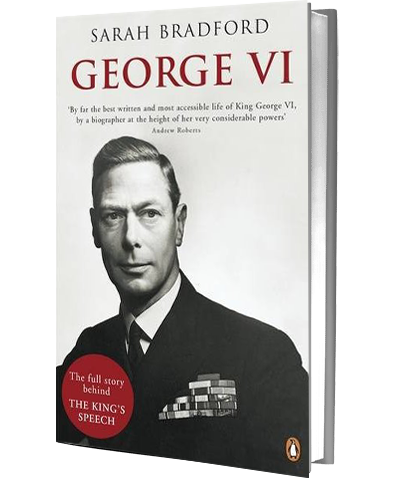
|
George VI
By Sarah Bradford
Acceding to the throne upon his brother's abdication, George VI was immediately confronted with the turmoil in European politics leading up to World War II, then the war itself, followed by a period of austerity, social transformation and loss of Empire. George was unprepared for kingship, suffering from a stammer which could make public occasions very painful for him. Moreover, he had grown up in the shadow of his brother, a man who has been idolised as no royal prince has been before or since. However, this biography shows that although George was not born to be king, he died a great one.
(Published by Penguin: 2011)
https://www.sarahbradford.co.uk/ |
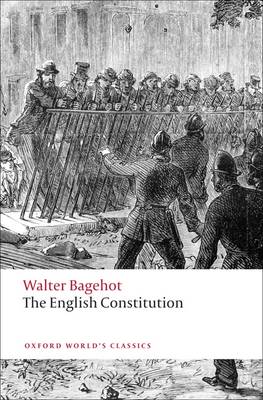
|
The English Constitution
By Walter Bagehot
"An ancient and ever-altering constitution is like an old man who still wears with attached fondness clothes in the fashion of his youth: what you see of him is the same; what you do not see is wholly altered."
First published in 1867, Walter Bagehot's The English Constitution is the best account of the history and working of the British political system ever written. As arguments raged in mid-Victorian Britain about giving the working man the vote, and democracies overseas were pitched into despotism and civil war, Bagehot took a long, cool look at the 'dignified' and 'efficient' elements which made the English system the envy of the world. His anaylsis of the monarchy, the role of the prime minister and the cabinet, and comparisons with the American presidential system are astute and timeless and pertinent to current discussions surrounding devolution and electoral reform.
Combining the wit of a journalist with the wisdom of a man of letters steeped in evolutionary ideas and historical knowledge, Bagehot produced a book which is always thoughtful, often funny, and seldom dull. This edition reproduces Bagehot's original 1867 work in full, and introduces the reader to the dramatic political events that surround its publication.
(Published by Oxford Paperbacks: 2009/also available in other editions)
https://global.oup.com/academic/product/the-english-constitution-9780199539017
|
|
Dignified and Efficient: The British Monarchy in the Twentieth Century
By Charles Douglas-Home
In a series of moving portraits of the monarchs and their advisors, Charles Douglas-Home and Saul Kelly examine the tasks with which recent crowned heads have been troubled, and the virtues that enabled them, bu and large, to act for the common good. Incisive, evocative, and informed by a magisterial vision of the scope of political power, this work offers a persuasive answer to the critics of monarchy and an account of a unique form of government that will give confidence and inspiration to the British people, as they enter a new century of shifting powers and uncertain prospects.
(Published by Claridge Press: 2000) |
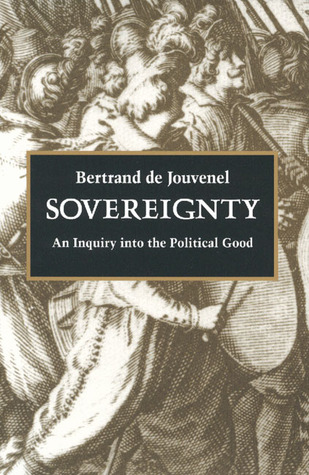
|
Sovereignty: An Inquiry into Political Good
By Bertrand de Jouvenel
'Who decides? Who is the Sovereign? What is a good act?' In quest of these answers to these vitally important questions, Bertrand de Jouvenel examines successively the nature and history of authority, the political good, the sovereign and liberty. His concern is with "...prospects for individual liberty in democratic societies in which sovereignty purportedly resides in the whole of the body politic." His objective is a definition and understanding of the "...canons of conduct for the public authority of a dynamic society." He writes for "...whoever would exercise the duties of a citizen."
Sovereignty is the sequel to Jouvenel's widely acclaimed On Power and was orginally published in 1955.
(Published by Liberty Fund: 1998) |
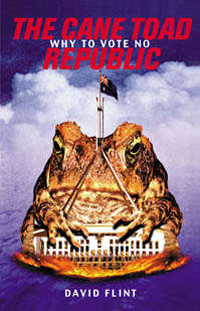
|
The Cane Toad Republic
By David Flint
"Today we dont have a problem with our constitution. It is the envy of the world. Yet, we are told we must make the biggest structural change to our constitution since federation, one which many republicans warn has the potential to subvert our democracy."
David Flint warns that the Keating-Turnball republic, the mode which Australians will vote on, is even worse than the disasterous importation of the cane toad. 'The Cane Toad Republic' is a readable and amusing outline of the 'No' case. But it is also a stark warning of the dangers that could follwo from a 'Yes' vote.
"It is a sure bet that the people who so blighely accept that the Keating-Turnball republic is timely and proof of our collective maturity haven't confronted the sort of hard-headed argument 'The Cane Toad Republic' has to offer." (Christopher Pearson:- Wakefield Press)
(Published by Wakefied Press: 1999) |
|
Lines of Succession Handbook: Heraldry of the Royal Families of Europe
By Jiri Louda & Michael Maclagen
'Lines of Succession'...presents a comprehensive account of both the heraldic and the genealogical history of European Royalty and is fully illustrated throughout. Beginning with heraldry in the fifteenth century, the two experts who collabourated to make the book present the heraldic shields as well as the genealogy of all the Royal families of Europe, past and present. The genealogical tables provide detailed family trees, country by country. The coat-of-arms representing the various matrimonial alliances show how heraldic devices evolved and developed from simple symbols to complex quarterings. Additional tables highlight the most important historical events involving dynastic succession. The text describes the historical background to each Royal family tree, and shows how such events are reflected in the makeup of the Royal coat of arms.
(Published by Little, Brown & Co: 1999)
|
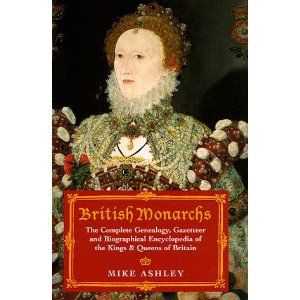
|
The British Monarchs
By Michael Ashley
A record of Britain's kings and queens who have ruled all, or part of, Britain covering more than 1000 monarchs and 2000 years of history. It includes the host of tribal and Saxon rulers prior to 1066, as well as famous monarchs such as Richard III, Elizabeth I and Charles II; and all the rulers of Scotland and Wales. Its provides full details of all the rulers wives, consorts, pretenders, usurpers and regents, as well as powerful nobles and dignitaries. There is also a listing of royal records such as who are the most, the least, the shortest, the largest, the richest, the poorest and a geographical guide to where all Britain's monarchs lived and died, including their palaces, estates and resting places.
(Published by Robinson Publishing: 1998)
|
|
Oliver Cromwell: King in all but name: 1653-1658
By Roy Sherwood
Oliver Cromwell as Lord Protector (1653-1658) is frequently described as 'king in all but name' without explaining exactly what this means. This book aims to correct the omission by demonstrating precisely in what way Cromwell's rule was a monarchical regime in the generally accepted sense of the term. The author challenges many widely held views about Cromwell, resulting in a portrayal of the man and his regime which is far removed from the stereotypical image of the Protector.
(Published by Sutton: 1997) |

|
The Monarchy and the Constitution
By Vernon Bogdanor
In the increasingly questioning world of the 1990s, the role of the monarchy in a democracy is again coming under scrutiny. Its critics argue that the monarchy's a profoundly conservative institution which serves to inhibit social change; that it has outlived its usefulness; that it symbolises and reinforces deference and hierarchy; and that its radical refrom is therefore long overdue. Rejecting these arguements Vernon Bogdanor makes a powerful case for the positive role that monarchy plays in modern democratic politics. Ranging across law, politics and history he argues that far from undermining democracy, the monarchy sustains and strengthens democratic institutions; that constitutional monarchy is a form of government that ensures not conservatism but legitimacy. The first serious examination of the political role of the monarchy to appear in many years, this book will make fascinating reading for all those interested in the monarchy and the future of British politics.
(Published by Oxford University Press: 1995)
https://global.oup.com/academic/product/the-monarchy-and-the-constitution-9780198293347
|

|
On Power: The Natural History of Its Growth
By Bertrand de Jouvenel
Documenting the process by which government and controlling majorities have grown increasingly powerful and tyrannical, Bertrand de Jouvenel demonstrates how democracies have failed to limit the powers of government. This development Jouvenel traces all the way back to the days of royal absolutism which established the large administrative bureacracies and thus laid the foundation of the modern omnipotent state.
On Power is an important work that Professor Angelo M. Petroni of the Luigi Einaudi Centre for Research in Torino, Italy, has said is "...simply a book that no serious scholar of political science or political philosophy can afford to ignore."
(Published by Liberty Fund: 1993)
|
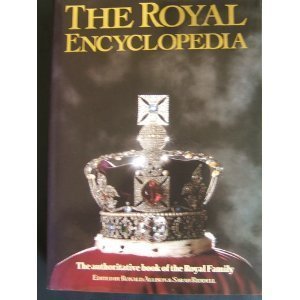
|
The Royal Encyclopaedia:
Authorised Book of the Royal Family
By R. Allison & S. Riddell
This book provides the reader with an inside view of the modern Royal Family. Containing facts about members of the Royal Family, their duties, palaces, collections of art, protocol, constitution, ceremonies, the Royal Household and the Royal offices this book should appeal to anyone interested in the Royal Family. Granted access to the files and archives of the Royal household, the editors of this book have compiled an array of information under a total of two hundred alphebetical entries. Includes information such as the correct way to address a member of the Royal Family and Princess Eugenie's birthdate. Accompanying the text are over five hundred photographs.
(Published by Macmillan: 1991)
|

|
Debrett's Kings and Queens of Britain
By David Williamson
This is the companion work to'Debrett's Kings and Queens of Europe' and provides a complete and personal survey of the monarchs of England from the early Celtic and Saxon kings to the House of Windsor. It includes additional charts and notes on the independent monarchs of Scotland, Wales and Ireland during the same period.
(Published by Webb & Bower: 1991)
|
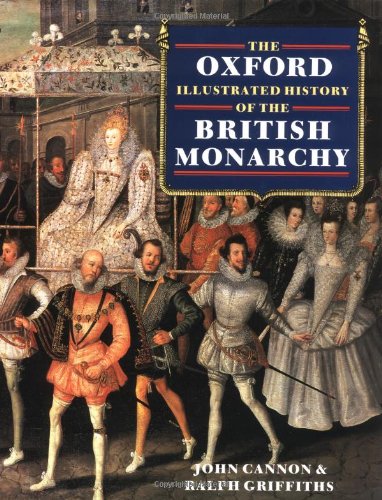
|
The Oxford Illustrated History of the British Monarchy:
By John Cannon & Ralph A. Griffiths
This illustrated account of the British monarchy presents a history of the individual kings and queens from Anglo-Saxon times to the present. From the Dark Ages of the fifth century this study follows the emergence of recognisable kingdoms in Scotland, Wales and England; the continental role of English monarchs from William the Conqueror to King John; and the refocussing of royal power in Britain from the thirteenth century with the extension of English rule to Wales, the consolidation of the Scottish kingdom and the forging of a new relationship between monarch and nation. Ralph Griffiths explains how key traditions have evolved- the right of succession, coronations and marriages, oaths of loyalty and military service, the granting of lands and titles, and the propagation of a powerful image of royalty.
These themes are taken up in John Cannons account of the monarchy from Henry VIII. He also discusses the changes that followed the loss of the throne in the Civil Wars and the development of mixed monarchy as the Hanoverians combined personal rule with government by Parliament. The final chapter describes the emergence of the constitutional role of the Crown in Queen Victoria's reign and the enduring basis that this has given the symbolic and popular monarchy of today. Alongside the story of power and government, the authors explore the many ways in which monarchs and the image of royalty have shaped social and cultural history as landowners, builders, sportsmen, patrons of the arts and the focus of court life, whether idealised or profane.
(Published by Oxford University Press: 1988)
|
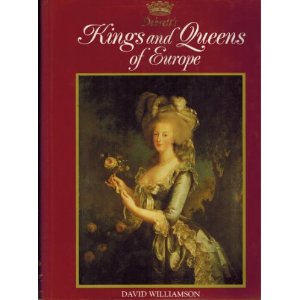
|
Debrett's Kings and Queens of Europe
By David Williamson
An excellent beginners book on the royal houses of Europe which provides an easy to understand overview of the various ruling familes and the key individuals within them. The work is arranged geographically and proceeds from West to East across the Continent; starting from Iberia and stretching across the Balkan states. The book provides brief accounts of the various rulers under discussion, a wonderful collection of illustrations and relatively easy to follow genealogical tables.
Please note that this work does not include discussion of the British Royal Family, a separate companion book provides a particular focus on the UK.
(Published by Webb & Bower: 1988)
|
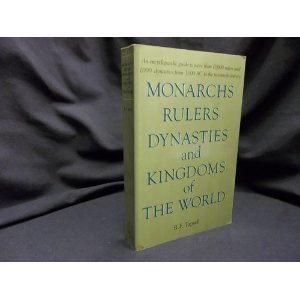
|
Monarchs, Rulers, Dynasties and Kingdoms of the World
By R.F. Tapsell
Subtitled; 'An Encyclopaedic Guide to more than 13,000 Rulers and 1000 Dynasties from 3000BC to the 20th Century'. Tapsell's work seeks to consolidate a comprehensive guide to kings, queens, sultans and emperors all into one volume. It includes many dynasties that are rarely described except in advanced studies of individual countries or regions. It provides a good reference for those seeking to find the main rulers of a particular part of the world at various times.
(Published by Thames & Hudson: 1984)
|
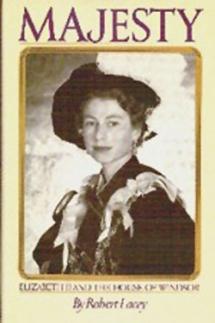
|
Majesty:
Elizabeth II and the House of Windsor
By Robert Lacey
What is it like to have a private audience with the Queen? To take tea or go on tour with her? To stay in one of her homes? What principles guided her as she chose Britain's Prime Ministers in 1957 and 1963? What has been her role in crises like the Suez, the Three Day Week and the dismissal of Australia's Prime Minister Gough Whitman? How does she feel about her sister? Her husband? Who are her friends?
Majesty is the world-wide best-selling biography of Queen Elizabeth II, one of the most prominent yet also one of the least known personalities in the world. Majesty is also the portrait of an institution-monarchy- which it is fashionable to ignore but which thrives in constitutional form, as healthily as ever. A fascinating and fitting tribute to Queen Elizabeth II's quarter of a century on the throne.
(Published by Hutchinson: 1977)
https://www.robertlacey.com/category/latest-books/
|
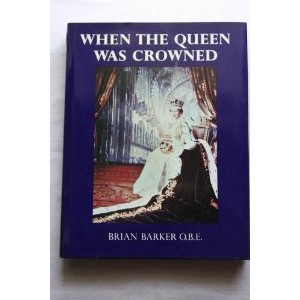
|
When the Queen was Crowned
By Brian Barker
Brian Barker's work sets out clearly and comprehensively every aspect of the pomp and ceremony surrounding the ritual of a royal coronation. Although focussing specifically upon the example of the coronation of HM Queen Elizabeth II, Barker uses this narrative as a means to deconstruct the various aspects of the what is at once a deeply solemn religious ritual, while also being an occasion of high-pagentry, to explore the historical roots and significance of the coronation as a ceremony.
Straddling the notions of constitutionality and legimate monarchy, Barker presents us with an image of a ceremony, and a Queen, which rests at the very heart of Britain's unique system of government.
(Published by Routledge & Kegan Paul: 1976)
|
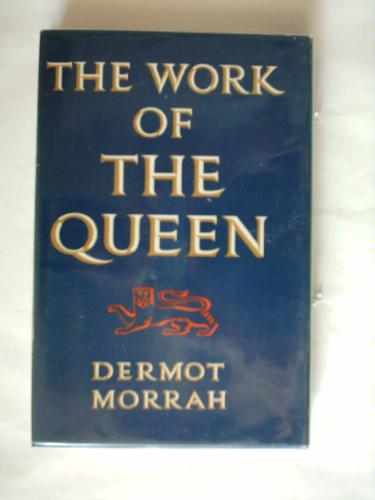
|
The Work of the Queen
By Dermot Morrah
Written by the former Arundel Herald Extraordinary, Morrah's work has been described as a thorough and comprehensive account of the day-to-day work and duties which befall the modern British monarch. Examining the mundane and practical tasks of constitutional head-of-state with detail, the work highlights the oft unseen nature, variety and weight of the matters that call for the monarch's personal decisions.
(Published by William Kimber: 1958)
|
|

